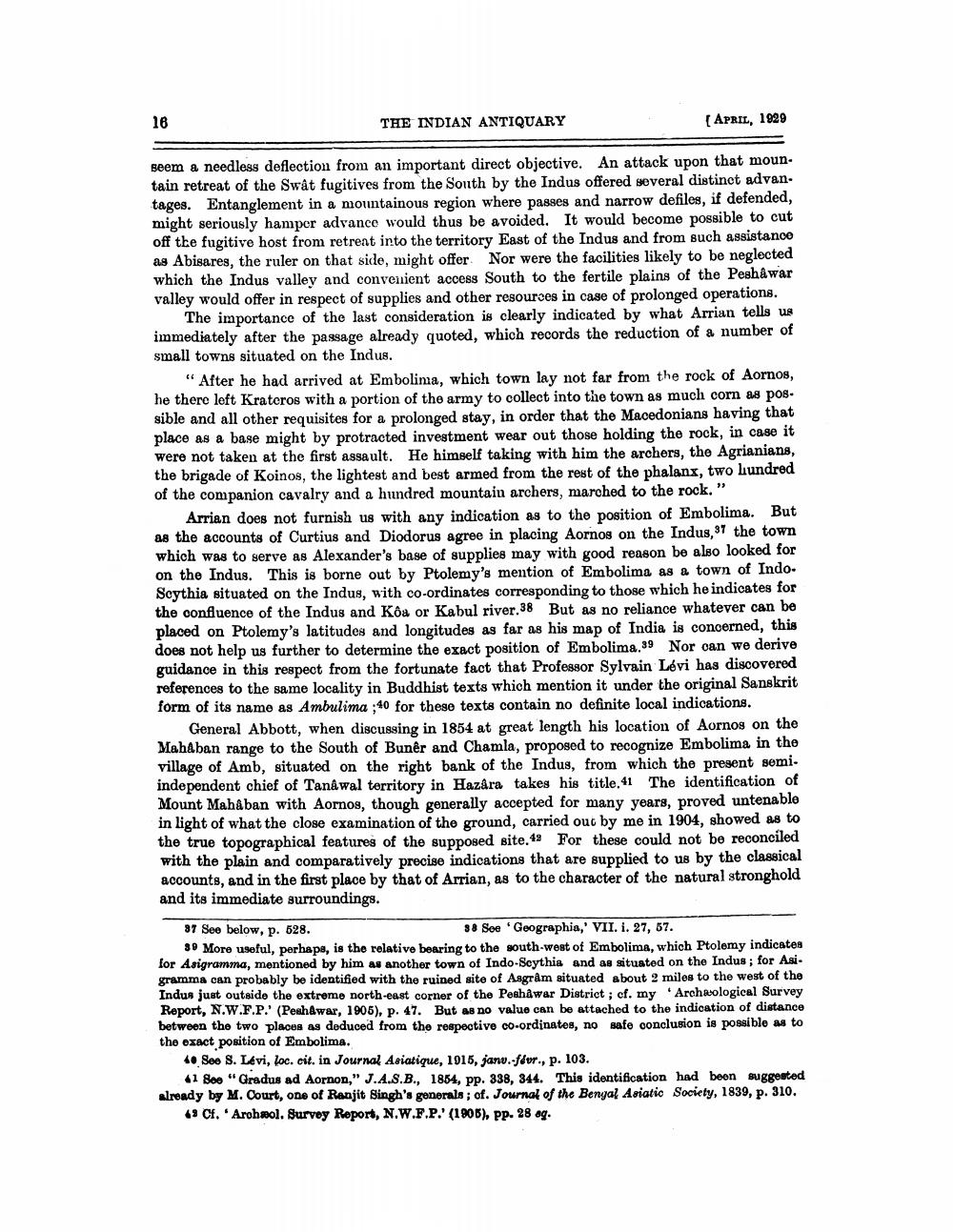________________
16
THE INDIAN ANTIQUARY
APRIL, 1929
seem a needless deflection from an important direct objective. An attack upon that moun. tain retreat of the Swât fugitives from the South by the Indus offered several distinct advan. tages. Entanglement in a mountainous region where passes and narrow defiles, if defended, might seriously hamper advance would thus be avoided. It would become possible to cut off the fugitive host from retreat into the territory East of the Indus and from such assistance as Abisares, the ruler on that side, might offer Nor were the facilities likely to be neglected which the Indus valley and convenient access South to the fertile plains of the Peshawar valley would offer in respect of supplies and other resouroes in case of prolonged operations.
The importance of the last consideration is clearly indicated by what Arrian tells us immediately after the passage already quoted, which records the reduction of a number of small towns situated on the Indus.
"After he had arrived at Embolima, which town lay not far from the rock of Aornos, he there left Kratoros with a portion of the army to collect into the town as much corn as pos. sible and all other requisites for a prolonged stay, in order that the Macedonians having that place as a base might by protracted investment wear out those holding the rock, in case it were not taken at the first assault. He himself taking with him the archers, the Agrianians, the brigade of Koinos, the lightest and best armed from the rest of the phalanx, two hundred of the companion cavalry and a hundred mountain archers, marched to the rock."
Arrian does not furnish us with any indication as to the position of Embolima. But as the accounts of Curtius and Diodorus agree in placing Aornos on the Indus, 87 the town which was to serve as Alexander's base of supplies may with good reason be also looked for on the Indus. This is borne out by Ptolemy's mention of Embolima as a town of Indo. Scythia situated on the Indus, with co-ordinates corresponding to those which he indicates for the confluence of the Indus and Koa or Kabul river.38 But as no reliance whatever can be placed on Ptolemy's latitudes and longitudes as far as his map of India is concerned, this does not help us further to determine the exact position of Embolima.39 Nor oan we derive guidance in this respect from the fortunate fact that Professor Sylvain Lévi has discovered references to the same locality in Buddhist texts which mention it under the original Sanskrit form of its name as Ambulima ; 40 for these texts contain no definite local indications.
General Abbott, when discussing in 1854 at great length his location of Aornog on the Mahaban range to the South of Buner and Chamla, proposed to recognize Embolima in the village of Amb, situated on the right bank of the Indus, from which the present semi. independent chief of Tanâwal territory in Hazara takes his title. 41 The identification of Mount Mahâban with Aornos, though generally accepted for many years, proved untenable in light of what the close examination of the ground, carried out by me in 1904, showed as to the true topographical features of the supposed site.42 For these could not be reconciled with the plain and comparatively precise indications that are supplied to us by the classical accounts, and in the first place by that of Arrian, as to the character of the natural stronghold and its immediate surroundings. 37 See below, p. 528.
38 Soe 'Geographia,' VII. i. 27, 57. 38 More useful, perhaps, is the relative bearing to the south-west of Embolima, which Ptolemy indicates for Asigramma, mentioned by him as another town of Indo-Seythia and as situated on the Indus; for Asigramma can probably be identified with the ruined site of Asgrâm situated about 2 miles to the west of the Indus just outside the extreme north-east corner of the Peshwar District ; cf. my 'Archeological Survey Report, N.W.F.P.' (PeshAwar, 1905), p. 47. But as no value can be attached to the indication of distance between the two places as deduced from the respective co-ordinates, no safe conclusion is possible as to the exact position of Embolima.
4. Seo S. Levi, loc. cit. in Journal Asiatique, 1915, janu..fdur., p. 103.
41 See "Gradus ad Aornon," J.A.S.B., 1854, pp. 338, 344. This identification had been suggested already by M. Court, one of Ranjit Singh's generals ; of. Journal of the Bengal Asiatic Society, 1839, p. 310.
18 Cf. Arohol. Survey Report, N.W.F.P.' (1906), pp. 28 sq.




